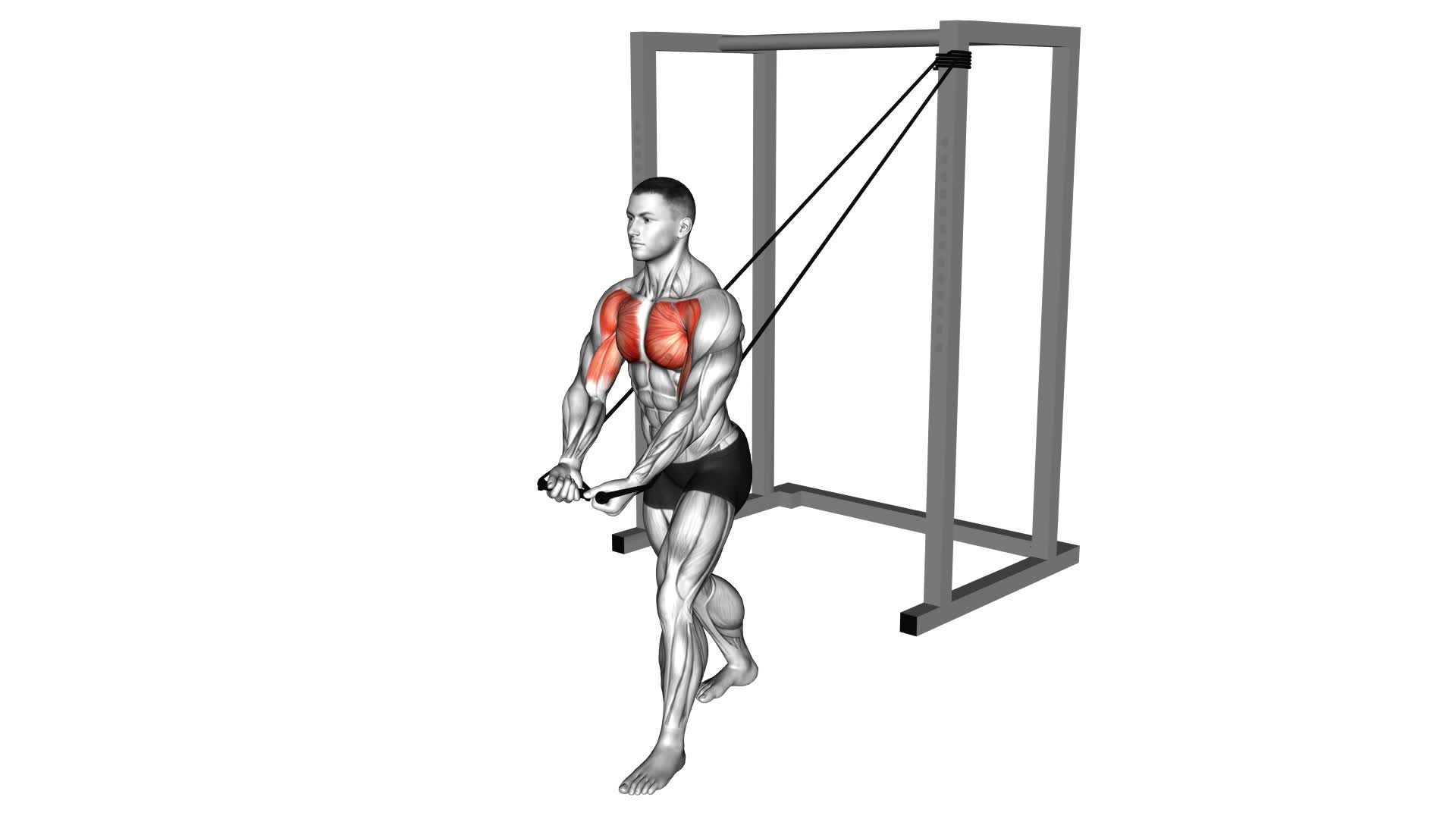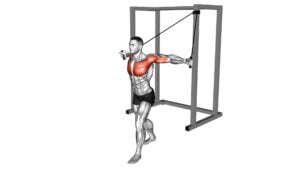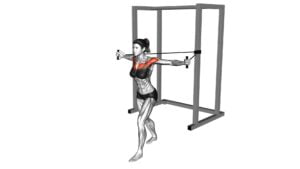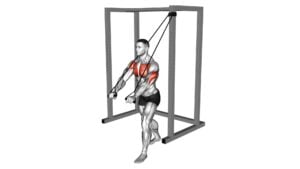Band Low Chest Fly (male) – Video Exercise Guide & Tips

Looking to build a stronger chest? Check out this video exercise guide for the Band Low Chest Fly.
Watch This Exercise Video
In just a few minutes, you'll learn the proper form, equipment needed, and variations of this effective exercise. Avoid common mistakes and maximize your results with these helpful tips.
Whether you're a beginner or experienced, this guide is perfect for anyone looking to target their chest muscles. Get ready to take your chest workout to the next level!
Key Takeaways
- The Band Low Chest Fly targets and strengthens chest muscles.
- It engages muscles in a different way with resistance bands compared to dumbbells or machines.
- The exercise isolates the pectoralis major and minor for a sculpted chest.
- It provides a greater range of motion and allows for variations to target different areas of the chest.
Benefits of the Band Low Chest Fly
To maximize the effectiveness of your chest workout, you can benefit from incorporating the Band Low Chest Fly exercise. This exercise specifically targets the muscles in your chest, helping to strengthen and tone them. By using resistance bands instead of traditional weights, you can engage your muscles in a different way, providing a unique challenge and maximizing your results.
One of the key benefits of the Band Low Chest Fly is its ability to isolate the chest muscles. This exercise specifically targets the pectoralis major and minor, helping to develop a well-defined and sculpted chest. Additionally, the resistance bands allow for a greater range of motion compared to dumbbells or machines, allowing you to fully stretch and contract your chest muscles for optimal growth.
Another benefit of the Band Low Chest Fly is its versatility. There are several variations you can incorporate to target different areas of your chest. For example, by adjusting the height of the bands, you can emphasize the upper or lower chest muscles. You can also vary the angle of your body to target different angles of the chest, such as incline or decline variations.
Incorporating the Band Low Chest Fly into your chest workout routine can provide numerous benefits, such as increased muscle activation, improved strength and definition, and enhanced range of motion. By experimenting with different variations, you can customize your workout to target specific areas of your chest and achieve your desired results.
Proper Form for the Band Low Chest Fly
To perform the Band Low Chest Fly with proper form, start by placing your hands at an optimal position on the resistance band. This will ensure maximum engagement of your chest muscles during the exercise.
Additionally, be mindful of avoiding any shoulder strain by maintaining a controlled and smooth movement throughout the exercise.
Optimal Hand Placement
Ensure proper form for the Band Low Chest Fly by placing your hands in the optimal position. To achieve the best results and maximize muscle activation, follow these guidelines:
- Start by gripping the resistance band firmly with your palms facing down.
- Position your hands slightly wider than shoulder-width apart, allowing for a comfortable and stable grip.
- Keep your wrists straight and aligned with your forearms to maintain proper form and prevent strain or injury.
- Throughout the exercise, maintain a controlled and steady grip on the resistance band to ensure stability and effective muscle engagement.
By placing your hands in the optimal position, you'll be able to engage your chest muscles effectively and perform the Band Low Chest Fly with proper technique.
Now, let's move on to the next section and learn how to engage your chest muscles for maximum results.
Engaging Chest Muscles
For optimal engagement of your chest muscles during the Band Low Chest Fly, focus on maintaining proper form and a controlled grip on the resistance band. This chest exercise technique requires you to anchor the resistance band at waist height, step forward, and hold the handles with your palms facing down.
As you bring your arms forward and across your body, squeeze your chest muscles and maintain tension on the band. Keep your elbows slightly bent and avoid locking them out to prevent strain on your joints.
By performing the exercise with proper form and a controlled grip, you'll effectively engage your chest muscles and maximize the benefits of this exercise.
Now, let's move on to the next section about avoiding shoulder strain.
Avoiding Shoulder Strain
To avoid shoulder strain during the Band Low Chest Fly, focus on maintaining proper form and a controlled grip on the resistance band. This will help prevent injury and promote shoulder stability. Here are some tips to keep in mind:
- Keep your shoulders down and back throughout the exercise.
- Engage your core and maintain a neutral spine.
- Avoid using excessive momentum or swinging motions.
- Control the movement and ensure a steady and controlled grip on the resistance band.
By following these guidelines, you can reduce the risk of shoulder strain and maximize the effectiveness of the Band Low Chest Fly.
Now, let's discuss the equipment needed for this exercise.
Equipment Needed for the Band Low Chest Fly
To perform the Band Low Chest Fly exercise, there are some essential equipment you'll need.
First, you'll need a resistance band with appropriate tension for your fitness level.
Additionally, a secure anchor point, such as a sturdy post or door frame, is necessary to attach the band and perform the exercise safely.
If you don't have a resistance band, you can try using dumbbells or cables as alternatives to achieve a similar chest fly motion.
Essential Equipment for Fly
You will need a band for the Band Low Chest Fly exercise. To perform this exercise effectively, it's important to have the necessary gear. Here are the essential equipment for the Band Low Chest Fly:
- Resistance band: This is the primary equipment needed for the exercise. Choose a band with appropriate resistance level based on your fitness level and goals.
- Door anchor: Attach the band securely to a door using a door anchor. This allows you to perform the exercise safely and effectively.
- Handles: Some bands come with handles that provide a comfortable grip while performing the exercise. These handles can enhance your workout experience.
- Exercise mat: Having a mat underneath you can provide extra cushioning and support during the exercise, making it more comfortable and enjoyable.
Alternatives to Band
If you don't have access to a resistance band, you can still perform the Band Low Chest Fly exercise by using alternative equipment. One option is using dumbbells or free weights. Lie on a bench or a stability ball and hold a dumbbell in each hand. Extend your arms out to the sides and then bring them together in a hugging motion.
Another option is using a cable machine. Attach D-handles to the cable machine at chest height and stand facing away from the machine. Pull the handles towards the center of your body, squeezing your chest muscles.
These alternatives provide similar benefits to the Band Low Chest Fly exercise and can be incorporated into your chest workout routine.
Variations of the Band Low Chest Fly
Exploring different ways to perform the Band Low Chest Fly can enhance your workout routine and target your chest muscles effectively. By incorporating bands of different resistance levels, you can add variety and challenge to your chest fly exercise.
Here are some variations you can try:
- Single-arm Band Low Chest Fly: Attach a resistance band to a stable anchor point at chest height. Hold the band with one hand and step away from the anchor point until you feel tension. Perform the chest fly motion with one arm at a time, focusing on maintaining proper form and control.
- Band Low Chest Fly with Resistance Band Loop: Place a resistance band loop around your wrists and perform the chest fly motion as usual. The resistance from the loop will engage your chest muscles even more.
- Band Low Chest Fly with Resistance Band Cross: Cross two resistance bands in front of you, holding the handles with each hand. Step back to create tension and perform the chest fly motion, feeling the resistance from both bands working your chest muscles.
- Band Low Chest Fly with Resistance Band and Dumbbells: Hold a dumbbell in each hand while performing the band low chest fly. The combination of resistance from the bands and the dumbbells will provide a challenging workout for your chest muscles.
Common Mistakes to Avoid During the Band Low Chest Fly
One common mistake to avoid during the Band Low Chest Fly is failing to maintain proper form and control. Proper form is essential to avoid injury and maximize the effectiveness of the exercise.
One common misconception is that using a heavier resistance band will give better results. However, using too much resistance can lead to improper form and increase the risk of injury. It's important to choose a resistance band that challenges you without compromising your form.
Another mistake to avoid is flaring your elbows out too far during the exercise. This can put unnecessary strain on your shoulders and decrease the effectiveness of the exercise. Instead, keep your elbows slightly bent and close to your body throughout the movement.
Lastly, avoid using momentum to complete the exercise. This can take the focus away from your chest muscles and result in an ineffective workout. Instead, focus on using slow and controlled movements to engage your chest muscles properly.
Tips for Maximizing the Effectiveness of the Band Low Chest Fly
To maximize the effectiveness of the Band Low Chest Fly, focus on maintaining proper form and control, as discussed in the previous section. In addition, there are a few tips you can incorporate to maximize your results and ensure you're performing the exercise correctly.
Here are some tips for maximizing the effectiveness of the Band Low Chest Fly:
- Engage your core: Throughout the exercise, make sure to engage your core muscles by pulling your belly button towards your spine. This will help stabilize your body and prevent excessive movement.
- Use controlled movements: Instead of rushing through the exercise, focus on performing slow and controlled movements. This will allow you to fully engage your chest muscles and maximize the effectiveness of each repetition.
- Maintain proper breathing techniques: Remember to exhale as you push the bands away from your body and inhale as you bring them back towards your chest. Proper breathing will help you maintain control and optimize your performance.
- Adjust the band tension: If you find the exercise too easy or too challenging, adjust the tension of the band accordingly. You should feel a moderate level of resistance throughout the movement.
Frequently Asked Questions
How Many Sets and Repetitions Should I Do for the Band Low Chest Fly Exercise?
To get the most out of the band low chest fly exercise, it's important to know how many sets and repetitions to do. The number of sets and reps can vary depending on your fitness level and goals.
Generally, it's recommended to start with 2-3 sets of 10-15 repetitions. This will help build strength and muscle endurance in your chest.
Remember to maintain proper form and technique throughout the exercise to maximize its benefits and prevent injuries.
Can Women Also Perform the Band Low Chest Fly Exercise?
Yes, women can definitely perform the band low chest fly exercise. Band resistance training offers numerous benefits for women, such as improving muscle tone and strength.
Additionally, there are variations of the band low chest fly exercise that cater to different fitness levels. Whether you're a beginner or an advanced exerciser, you can adapt this exercise to suit your needs.
It's a great way to target and strengthen your chest muscles.
Is It Necessary to Warm up Before Performing the Band Low Chest Fly Exercise?
It's important to warm up before performing any workout, including the band low chest fly exercise. Incorporating warm up exercises helps increase blood flow to the muscles, improves flexibility, and reduces the risk of injury.
To perform the band low chest fly exercise with proper form and technique, anchor the band at chest height, stand with your feet shoulder-width apart, and bring your arms forward in a hugging motion. Remember to maintain control and engage your chest muscles throughout the movement.
How Often Should I Incorporate the Band Low Chest Fly Exercise Into My Workout Routine?
Incorporating the band low chest fly exercise into your workout routine has several benefits. It targets your chest muscles, helping to build strength and definition.
To perform this exercise with proper form and technique, start by attaching a band to a sturdy anchor point. Hold the handles with your palms facing down and extend your arms out in front of you.
Slowly bring your arms out to the sides, squeezing your chest muscles.
Aim to incorporate this exercise into your chest routine 2-3 times per week for optimal results.
Are There Any Alternative Exercises That Target the Same Muscles as the Band Low Chest Fly?
If you're looking for alternative exercises that target the same muscles as the band low chest fly, there are a few options you can try.
Push-ups and dumbbell chest presses are both effective exercises for targeting the chest muscles.
Additionally, you can incorporate cable chest flys or medicine ball chest passes into your routine.
These exercises will help you engage the same muscles as the band low chest fly and add variety to your workout.
Conclusion
Overall, the band low chest fly is a great exercise for targeting and strengthening the chest muscles.
By using resistance bands, you can effectively engage the muscles and achieve results.
Remember to maintain proper form, use the appropriate equipment, and avoid common mistakes to maximize the effectiveness of this exercise.
Incorporate variations to keep challenging your muscles and continuously progress.
With dedication and consistency, you can achieve a stronger and more defined chest.

Author
Years ago, the spark of my life’s passion ignited in my mind the moment I stepped into the local gym for the first time. The inaugural bead of perspiration, the initial endeavor, the very first surge of endorphins, and a sense of pride that washed over me post-workout marked the beginning of my deep-seated interest in strength sports, fitness, and sports nutrition. This very curiosity blossomed rapidly into a profound fascination, propelling me to earn a Master’s degree in Physical Education from the Academy of Physical Education in Krakow, followed by a Sports Manager diploma from the Jagiellonian University. My journey of growth led me to gain more specialized qualifications, such as being a certified personal trainer with a focus on sports dietetics, a lifeguard, and an instructor for wellness and corrective gymnastics. Theoretical knowledge paired seamlessly with practical experience, reinforcing my belief that the transformation of individuals under my guidance was also a reflection of my personal growth. This belief holds true even today. Each day, I strive to push the boundaries and explore new realms. These realms gently elevate me to greater heights. The unique combination of passion for my field and the continuous quest for growth fuels my drive to break new ground.







